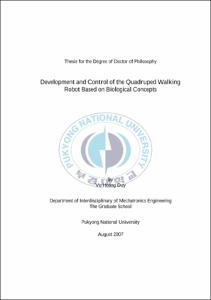Development and Control of the Quadruped Walking Robot Based on Biological Concepts
- Alternative Title
- 생물학적 개념에 기반한 4족 보행로봇의 개발 및 제어
- Abstract
- Locomotion produced by a quadruped is a complex process. It requires thecoordination of multiple degrees of freedom. In addition, locomotion control iscomplex because it requires adapting to terrain, optimizing the gait and trying tosatisfy multiple constraints. Therefore, designing quadruped robot must determineseveral related factors such as leg configuration, method of walk, algorithmcontrol, motion conditions and so on. These factors have influence on thelocomotion of the robot. Among of them, the two important factors are as follows:one is the mechanical structure and leg configuration, another is the method oflocomotion and the control system.
In this dissertation, a new approach is proposed for designing quadruped robotbased on the skeleton of dog and the following two concepts: one is mechanicalstructure and leg configuration which are designed to simplify the operation ofactuator, the other is the method of locomotion and the control system ofquadruped robot which can walk and run in a bounding gait with anuncomplicated control system. In order to obtain the flexible walking locomotionof quadruped robot, two controllers are proposed. The first controller is a mixedH2/H∞ PID controller. To design this controller, the followings must be considered.Firstly, each leg is modeled as a planar two-linked manipulator. Secondly, thetracking reference is a straight line which is parallel with the ground. The robot iscontrolled so that the hip joint of quadruped robot is moved along this line.Thirdly, this controller is used to track the tracking reference according kinematiccontrol method. Based on the H2 criterion, the hip joint is optimal to follow thetracking reference. Even the presence of the reaction forces considered as externaldisturbance, the influence of reaction forces is rejected by the H∞ criterion. Thesecond controller is central pattern generator (CPG) controller based on the fullbiological concepts to develop quadruped walking robot including mechanicaldesign and controller design. The CPGs generate a rhythmic generator which hasbeen proven to be involved in rhythmic activities such as locomotion, respirationand heartbeat. Locomotion using CPG attracts the attention because the motion ofeach joint can be modeled as the interaction between a nervous system and amechanical system. As mentioned above, the quadruped robot is designed tosimplify the operation of actuator by leg configuration. Therefore, hardware of thecontrol system to implement this controller for the new quadruped robot can besimplified. That is, the control system consists of three microcontrollersPIC18F4431: one for master unit and two for slave units. Each slave unit isutilized to control two diagonal legs. Each leg is connected with twopotentiometers to measure hip and knee joint angles. Four touch sensors are usedfor sensing four feet on the ground. The master unit is functionalized as maincontroller communicating between two slave units via RS485 communication.Numerical simulation and experiment results on the quadruped robot are shown toprove the effectiveness of the proposed model.
- Issued Date
- 2007
- Awarded Date
- 2007. 8
- Type
- Dissertation
- Publisher
- 부경대학교 대학원
- Affiliation
- 부경대학교 대학원
- Department
- 대학원 메카트로닉스공학협동과정
- Advisor
- 김상봉
- Table Of Contents
- Chapter 1: Introduction = 1
1.1 Overview of the Quadruped Robot Model = 1
1.2 Overview of the Quadruped Robot Control = 10
1.3 Motivation of the Dissertation = 12
1.4 Thesis Contributions and Organization = 13
Chapter 2: Quadruped Locomotion = 15
2.1 Quadruped Locomotion = 15
2.1.1 Walk = 15
2.1.2 Trot and Pace = 16
2.1.3 Gallop = 18
2.1.4 Fly = 19
2.2 Neural Control of Locomotion = 20
2.2.1 Control of Skeletal Muscles and the Stretch Reflex = 20
2.2.2 Central Pattern Generator = 23
2.2.3 Legged Locomotion Based on Biological Concepts = 26
Chapter 3: A New Approach for Designing Quadruped Robot = 28
3.1 Introduction = 28
3.2 Overview of the Quadruped Robot Design Ideas = 31
3.2.1 Reduced DOF with Flexible Leg = 32
3.2.2 Leg Structure Based on a Musculoskeletal Model of a Dog = 33
3.2.3 Quadruped Robot = 37
3.3 Overview of the Quadruped Robot Control Ideas = 39
3.3.1 Walking in the Quadruped Robot = 39
3.3.2 Bounding in the Quadruped Robot = 42
3.3.3 Hardware of the Quadruped Robot = 42
3.4 Summaries = 44
Chapter 4: Control of the Quadruped Walking Robot = 46
4.1 Introduction = 46
4.2 A Mixed H₂/H_(∞) PID Control Problem Description = 46
4.3 A Mixed H₂/H_(∞) PID Controller Design = 52
4.3.1 Chromosome Coding and Decoding = 52
4.3.2 Fitness and Cost Function = 53
4.4 The Proposed Control Scheme = 56
4.5 Simulation and Experimental Results = 56
4.5.1 Simulation Results = 59
4.5.2 Experimental Results = 64
4.6 Summaries = 67
Chapter 5: Control of the Quadruped Walking Robot Based on Biological Concepts = 68
5.1 Introduction = 68
5.2 Central Pattern Generators (CPG) = 69
5.2.1 Neural Oscillator Model = 69
5.2.2 The General Model Based on CPG Controller for Quadruped Locomotion = 71
5.2.3 The Proposed Control Scheme = 72
5.2.4 Virtual CPG Controller for Hip Joints = 74
5.2.5 CPG Controller for the Knee Joint = 76
5.3 Simulation and Experimental Results = 78
5.4 Summaries = 80
Chapter 6: Conclusions and Future Works = 81
6.1 Conclusions = 81
6.2 Future Works = 83
References = 85
Publications and Conferences = 91
- Degree
- Doctor
- Appears in Collections:
- 대학원 > 메카트로닉스공학협동과정
- Files in This Item:
-
-
Download
 Development and Control of the Quadruped Walking Robot Based on Biological Concepts.pdf
기타 데이터 / 2.23 MB / Adobe PDF
Development and Control of the Quadruped Walking Robot Based on Biological Concepts.pdf
기타 데이터 / 2.23 MB / Adobe PDF
-
Items in Repository are protected by copyright, with all rights reserved, unless otherwise indicated.